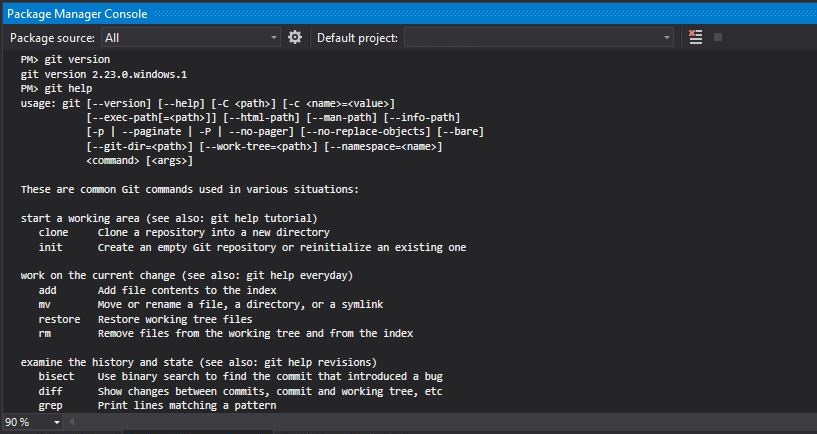

- #VISUAL STUDIO PACKAGE MANAGER CONSOLE INSTALL INSTALL#
- #VISUAL STUDIO PACKAGE MANAGER CONSOLE INSTALL CODE#
- #VISUAL STUDIO PACKAGE MANAGER CONSOLE INSTALL DOWNLOAD#
- #VISUAL STUDIO PACKAGE MANAGER CONSOLE INSTALL WINDOWS#
BaGet Host " // GitLab Host " // Nexus Host " "": [ Settings You can override the following settings in the User or Workspace settings.json: /index.json"
#VISUAL STUDIO PACKAGE MANAGER CONSOLE INSTALL INSTALL#
Search and install new packages from NuGet Server.
#VISUAL STUDIO PACKAGE MANAGER CONSOLE INSTALL CODE#
For instance if you need to exclude json data a plugin generates during production.NuGet Package Manager GUI For VSCode An extension for Visual Studio Code that lets you easily update/remove/install packages from NuGet server for. pubxml files in the properties/Publish folder. Should you need to exclude any of these folders or content, you can add a target to your. You can see these folders in packages/UmbracoCms x.y.z/build/UmbracoCms.targets. Note that the Umbraco NuGet package adds a build step to always include the Umbraco folders when you deploy using Web One-Click Publish with Visual Studio. You can now run the site like you would normally in Visual Studio (using F5 or the Debug button).įollow the installation wizard and after a few steps and choices you should get a message saying the installation was a success. Then type Install-Package UmbracoCms to start installing the latest version of Umbraco.
#VISUAL STUDIO PACKAGE MANAGER CONSOLE INSTALL WINDOWS#
You can do the exact same thing from the package manager console, which is a bit quicker as you don't have to click through the menus and search.Įnable the console by going to Tools > View > Other Windows > Package Manager Console.
#VISUAL STUDIO PACKAGE MANAGER CONSOLE INSTALL DOWNLOAD#
NuGet will then download dependencies and will install all of Umbraco's files in your new solution. So make sure to pick Umbraco CMS (highlighted in the image below) and click the Install icon (arrow down). You'll also find the Umbraco CMS Core Binaries package and the Umbraco CMS Web package, they will be included automatically when you choose Umbraco CMS. You can then use the search function to find the package called UmbracoCMS. To install Umbraco from the Visual Studio interface, right-click on the new project you've made and choose Manage NuGet Packages. All you have to do is search for it and install. The latest release of Umbraco is always available in the NuGet gallery. Umbraco will add them for you).įinding and installing the Umbraco package (Don't enable any of the checkboxes to add folders or core references. It's important to pick empty as other templates include incompatible versions of MVC and Json.NET. On the next step, select the Empty template.

Similarly, refrain from naming your solution Umbraco, as this will cause a namespace conflict with the CMS itself. NET Framework 4.7.2, Umbraco will not work with lower versions than 4.7.2. Note: Double check that in the "Framework" dropdown you've selected. Go to File > New Project and pick an ASP.NET Web Application. Note: Check that your Visual Studio version is at least 15.9.6 ( Help > About Microsoft Visual Studio), lower versions do not install the correct NuGet dependencies. To install Umbraco we first need a Visual Studio solution. The screenshots below are for Visual Studio 2017, but you should follow a similar journey for 2019. Creating Tables for Umbraco with PetaPoco.Displaying the Document Type Properties.Creating Your First Template and Content Node.


 0 kommentar(er)
0 kommentar(er)
